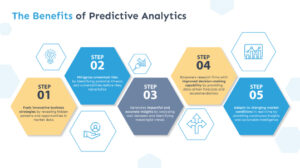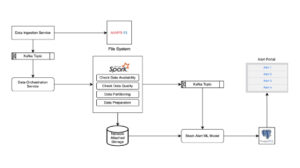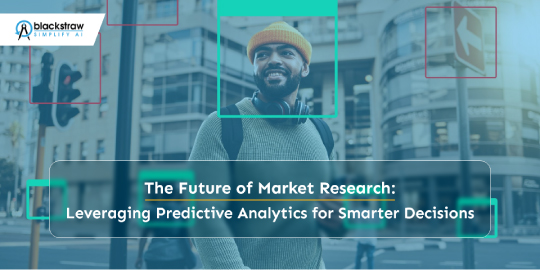Market research no longer relies solely on manual processes to understand data. AI integration has ushered in a new era in which sophisticated algorithms and real-time insights drive forecasting and decision-making.
As businesses strive for a competitive advantage, predictive analytics has become a necessity. With the global market projected to reach $95.30 billion by 2032 , it’s clear that AI-driven insights are reshaping business strategies across industries. Advanced AI-powered tools and analytics enable market research firms to:
- Gain actionable foresight: Study consumer behavior, competitor moves, and industry trends for data-driven strategies.
- Stay ahead of market trends: Identify business opportunities early on through precise trend tracking and timely actions.
- Create AI-powered focus groups to gain deeper insights: Analyze customer feedback to better understand brand perceptions, driving informed decision-making.
- Comprehensive competitor analysis: Track KPIs to identify strengths and weaknesses, providing a clearer understanding of your competitive position.
Predictive Analytics: How Does it Work for Market Research?
Predictive analytics integrates machine learning, big data, and natural language processing (NLP) to provide detailed and actionable insights. Here’s how it works:
Data Integration and Big Data: Integrating various data
sources, such as transactional, behavioral, and social data, enhances a predictive model’s accuracy. But here’s the challenge: Handling big datasets.
The solution? AI tools that streamline data management and allow seamless scaling.
Machine Learning: Machine learning algorithms are the foundation of predictive analytics. These algorithms identify patterns and predict trends. They can be trained on historical data to learn and adapt, constantly refining their predictions.
Natural Language Processing: Tracking public perception about brands and products is crucial for anticipating potential crises and shaping marketing messages. NLP allows AI models to understand and interpret human language, enabling sentiment analysis. This helps extract valuable insights from unstructured data like social media posts and product reviews.

Predictive Analytics in Action: Transforming Market Research
Use cases of predictive analytics in market research are both diverse and powerful. Here are some key areas where this technology is making an impact:
Anticipating market shifts
Demand forecasting is a stellar use case of predictive analytics in market research. Firms can accurately predict demand shifts by leveraging historical data, current trends, and external factors. This capability is crucial in the modern, fast-paced business environment, where being reactive is no longer enough. Staying ahead of trends is essential, and predictive insights help companies make proactive decisions, optimize resources, and drive growth.
Anticipating market shifts
A leading business intelligence and analytics software company collaborated with a major American fast-food restaurant chain in the latter’s market research initiative by analyzing customer behavior through point-of-sale (POS) data. Mapping the POS data uncovered a direct correlation between store remodels and increased sales. Based on these insights, the food chain launched a strategic plan to speed up location remodels. They increased the number of remodels five fold in one year, driving significant sales growth.
Trend analysis and consumer behavior insights
Predictive analytics empowers market research firms to respond to current trends and identify ones that can boost business value. This foresight provides a significant competitive advantage in rapidly changing markets. Market research firms use advanced algorithms and large datasets to analyze patterns across various channels, including social media activity, search trends, consumer behavior, and macroeconomic indicators.
Using a predictive model to identify untapped markets for a global sports brand
A prominent market research firm developed an intelligence model for the sportswear market using alternative data sources, geo-marketing, and mobility data. The resulting reports offered interactive visualizations highlighting current trends and consumer buying preferences for sports articles and clothing. It assessed interest levels in each city, compared performance with other countries where the brand operates, and provided consumption forecasts to identify underserved target markets in various locations.
Competitive analysis
Predictive analytics empowers market research firms to conduct insightful competitive analysis by spotting emerging trends and shifts in competitor strategies. By examining pricing models, product launches, and marketing campaigns, firms can provide clients with actionable insights into their rivals’ game plans. This helps them anticipate competitive threats and identify new opportunities while fine-tuning their strategies. Additionally, predictive analytics offers a clear benchmark, showing clients exactly where they stand in their industry.
Predictive analytics for competitive analysis in telecom
Market research firms in the telecom domain apply predictive analytics to assess competitor pricing strategies, forecast consumer churn, and identify trends in service offerings. By analyzing large datasets, analytics teams of market research firms provide actionable insights to help telecom companies stay ahead of competitors.
This comparative case study highlights how various telecom companies leveraged predictive analytics to optimize pricing models and enhance customer retention strategies.
Predictive advertising
Market research companies can significantly enhance predictive advertising through predictive analytics. By analyzing large datasets, firms can better understand behavioral patterns and preferences to develop highly targeted advertising campaigns. For example, predictive models can determine the best time to launch ad campaigns, which products to promote, and which audience segment(s) to target.
Predictive campaigns result in 35% more target audience reach for global luggage brand
A global travel luggage brand partnered with a market research firm to optimize the second phase of its campaign, which focused on increasing visibility through high-impact ads and targeting a premium audience (ages 25-54) with data layering. Based on digital ad ratings, the brand tracked daily campaign performance across multiple channels to assess its impact, reach, and frequency. The campaign achieved a target audience reach of 35% and an on-target percentage of 65%. Further, daily reporting and optimization resulted in improved performance and a 3x cost optimization.
Make smarter business decisions based on AI-powered insights.
The Benefits of Predictive Analytics: Smarter, Faster, More Resilient Decision-making
Adopting predictive analytics in market research brings many benefits that can transform how businesses operate and compete.
- Fuels innovative business strategies by revealing hidden patterns and opportunities in market data
- Mitigates unwanted risks by identifying potential threats and vulnerabilities before they materialize
- Generates impactful and accurate insights by analyzing vast datasets and identifying meaningful trends
- Empowers research firms with improved decision-making capability by providing data-driven forecasts and recommendations
- Adapts to changing market conditions in real-time by providing continuous insights and actionable intelligence

Navigating the Challenges
While predictive analytics offers immense benefits, businesses may encounter a few challenges in implementing it. However, adopting the right strategies and resources can help businesses address these obstacles.
Ensuring data quality
Accurate and reliable data is the foundation of effective predictive modeling in market research. To mitigate risks associated with erroneous/obsolete data, firms should invest in advanced data management tools and implement automated data cleansing processes that eliminate inaccuracies. Strict data governance policies must be established to ensure compliance and ethical data use. Also, standardizing data sources, validating accuracy, and maintaining consistency across systems will enhance data quality and support effective predictive analytics.
Addressing bias in data and algorithms
Data sources often reflect existing biases. So, algorithms need to be built to reduce bias and promote fairness. This means finding and fixing biases in the data, using a variety of training datasets, and applying fairness measures to check how the models perform.
Ensuring explainability of AI models
The focus must be on creating easy-to-understand AI models that build trust in complex predictive systems and ensure compliance. Systems that clearly explain how they make decisions boost confidence among stakeholders and meet legal requirements. Investing in tools and processes that make AI insights transparent and easy to understand will enhance trust and support more informed decision-making.
Managing errors and exceptions in production models
Even well-designed predictive models can encounter unexpected errors or exceptions when deployed in real-world production environments. These issues can arise from various sources, such as changes in data distributions, system failures, or unforeseen edge cases. To ensure model reliability and performance, businesses must implement robust error-handling mechanisms, continuous monitoring systems, and fallback strategies.
Navigating ethical considerations
AI and data must be used responsibly and ethically. Businesses must adhere to data protection regulations, ensure transparency in data collection, and implement robust security measures to safeguard privacy. AI models should avoid perpetuating discrimination or exacerbating inequalities.
Blackstraw.ai: Your partner in AI-driven market research
Blackstraw.ai’s AI consulting and implementation services address key challenges in predictive analytics implementation. Through strategic consulting services, we conduct thorough evaluations of your business operations to identify areas where AI can drive the most value.
Our experts ensure accurate and reliable predictions through data quality assessment, tailored strategies, and robust data management. We combat data bias using diverse training datasets, sophisticated algorithms, and fairness measures, building unbiased models that promote fair decision-making and ensure compliance.
Blackstraw.ai also provides operationalization services, including deployment, inaccuracy management, and AI model management to maintain model accuracy over time. We continuously monitor AI model performance, identifying and addressing issues like concept drift or data quality degradation. Our proactive approach includes regular model retraining and fine-tuning, ensuring the long-term effectiveness of AI solutions.
How Blackstraw Helped a Leading US Market Research Firm Cut Costs by $15M
A leading US market research company designed a predictive analytics-based stock alert notification system that provided SKU-level alerts to retailers and vendors. The system relied on a commercial data warehouse, incurring multi-million-dollar license fees annually.
Problem Statement
The company wanted to retire its commercial data warehouse – Vertica – to eliminate the high annual license fees without compromising the performance of the notification system SLA.
Solution Offered
Blackstraw proposed migrating the data storage to a centralized system using Map RFS, as the client predominantly relied on on-premise infrastructure. To handle the multi-retailer data required for stock alerting, we implemented a Spark-based system, which provided superior performance in alignment with Map RFS.
To further enhance efficiency, our team partitioned the data across multiple layers. This approach ensured that each algorithm only read the data partition relevant to the specific user group, minimizing redundant data reads. This design enabled multiple parallel processing jobs, improving scalability and system performance.
Results Achieved
Cost Savings: The company saved over $15 million annually by eliminating the Vertica license.
Scalability: The new system supported better scalability, ensuring the company could handle growing data demands without compromising its SLA.
Improved Performance: Multi-level data partitioning and an optimized Spark-based system enabled parallel data processing with lower computational and memory requirements.

Why Blackstraw.ai?
The future of market research is undoubtedly predictive, with advanced analytics transforming how the industry operates. As these technologies evolve, market research firms will provide more refined services, like real-time sentiment analysis and automated trend forecasting. With AI-driven scenario planning, businesses will gain deeper insights into consumer behavior and market dynamics, allowing them to navigate competitive landscapes with confidence and agility. These innovations promise to make market research not just smarter but also more responsive to the changing world around us.
Blackstraw.ai is leading this revolution, offering AI-powered solutions for more efficient and data-driven insights. Our advanced tools provide critical insights for enhanced performance, helping market research firms and their clients stay ahead.
With Blackstraw.ai , the future of AI and data analytics in market research opens new doors for growth and opportunity. We empower market research firms not just to analyze the present but to predict the future, delivering unparalleled value to their clients in an increasingly data-driven world.
Ready to transform your market research capabilities with cutting-edge predictive analytics?
Read Also : Shaping the Future of AI: Customized Solutions, Strategic Innovation, and Human Impact




